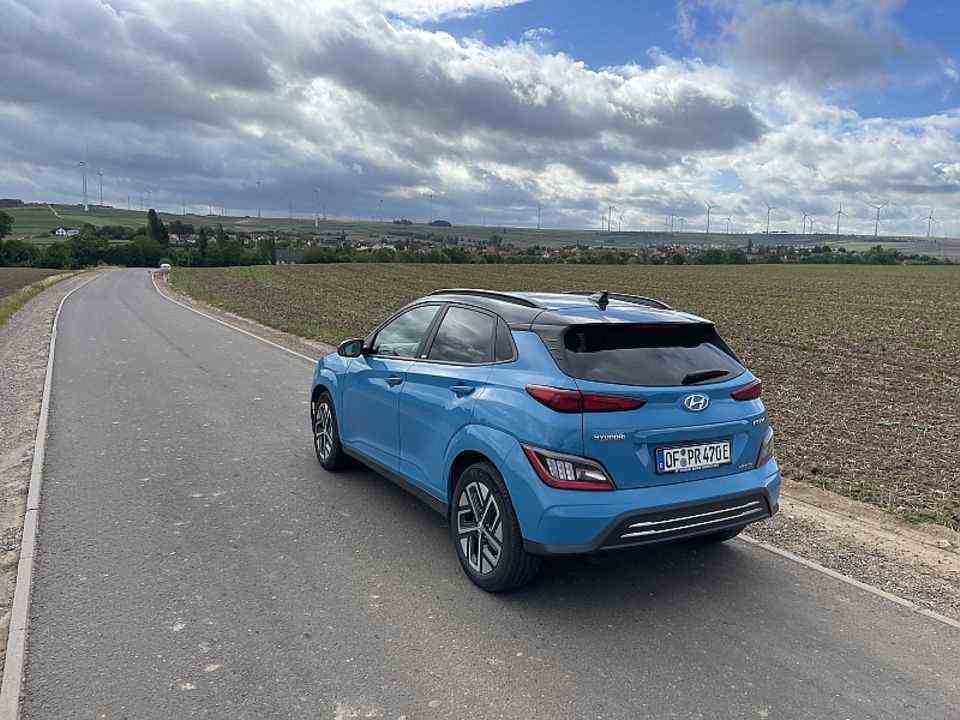Hyundai Kona Electric
Noticeably economical
Hyundai Kona Electric 2022
© press-inform – the press office
The Hyundai Kona is one of the most economical electric models on the market. Even three years after its premiere, the design still takes getting used to, but it offers its customers many options.
The face with the deep headlight eyes is a matter of taste, although the facelift has done him good. Even since it looks like an SUV or crossover, the Kona Electric is still only available with a front-wheel drive and, especially with the more powerful version with 150 kW / 204 PS, it has a lot of trouble on wet roads or bends, which is anything but Converting opulent engine power on the road into propulsion. A permanent magnet synchronous electric motor works in both motor variants, the power of which is transferred to the front wheels via a single-stage reduction gear. One can only hope that the successor, under discussion for 2023, will at least come with all-wheel drive technology if requested.
But apart from the twitching steering wheel when accelerating too quickly, the Hyundai Kona Electric can hardly be blamed, because it offers a lot of car for a manageable sum, because the basic version with its 100 kW / 136 PS and the small 39.2 kWh battery pack costs just now one time 35,650 euros. That is enough for just over 300 kilometers of electric range before it goes back to the socket. No surprise that many of the customers still opt for the larger and therefore significantly more expensive solution. The so-called Prime package is available for a very impressive premium of 12,800 euros, which increases the engine output to 150 kW / 204 PS and combines it with the 64 kWh battery package and a three-phase onboard charger. If you still order the 600 Euro contrast roof, you push the purchase price down to an impressive 49,050 Euro.
With the large battery pack, the range increases to around 480 kilometers until the next charging stop and the Hyundai Kona Electric does indeed offer a solid real range, because if you don’t shamelessly press the accelerator, the Korean’s thirst for electricity is manageable. With 14.7 kWh per 100 kilometers, it is significantly more economical than most of its competitors, who are, however, often larger and heavier. The battery pack with lithium-ion polymer technology is built into the vehicle floor, as is generally the case, which increases the seating position both front and rear accordingly. It takes three quarters of an hour to charge the battery up to 80 percent. The maximum charging speed at a fast charging station is 100 kilowatts; if only 50 kW are available, it takes just over an hour. The more powerful Kona variant with 150 kW / 204 PS has an 11 kW onboard charger for three-phase charging as standard. The time for a complete charging cycle is around three and a half hours in the 100 kW variant and five and a half hours in the 150 kW variant.
The driving performance of the 1.7-ton Hyundai Kona Electric is definitely okay, because the Korean-based company, with its production facility in the Czech Republic, is not built for long high-speed motorway sections. Right from the start, the SUV accelerates extremely ambitiously thanks to its maximum torque of 395 Nm, sometimes even tugging inharmoniously on the front axle. From a standing start it goes to 100 km / h in 7.9 seconds and the top speed is sealed off at 167 km / h. The intermediate sprint from 80 to 120 km / h, which the crossover does in under five seconds, is more impressive. You can still support the selected driving mode with the steering wheel pedals and act on the recuperation. At best, the compact class can be moved almost completely with the accelerator pedal. The chassis is more comfortable than that of most electric vehicles, which is not least due to the fact that the Kona, like its driver, does not waste any thought on sporting ambitions. So you can also come to terms with the rather callous steering, with which it can be parked easily and without problems, but otherwise the feedback from the road surface is missing.
In any case, service and space are more important to most customers. Here the electric Hyundai is at the usual level for its class and has enough space for four people. It gets too tight for five – not only in the rear, because with a luggage volume of 332 liters, around 40 liters less are available than with the combustion engine – you can live with that. And even if only 1,114 liters are available after folding down the rear seats – that should be enough for most users. Dad is more annoyed that there is not even an electric tailgate control for an extra charge and the payload of 350 to 410 kilograms is anything but generous. In contrast, the space available in this league is okay, although the rear seats should be a bit flatter and the space under the front seats is manageable.
The driver looks at appropriately informative instruments that are fully animated and easy to read. The central screen and the direct buttons below it in the center console fit well; however, the dashboard for the light modules and parking aid is difficult to see above the driver’s left knee and is therefore anything but ideally positioned. And the time for a head-up display that projects its information onto an extendable plastic pane is long gone and the design has never been valuable in any vehicle. Hopefully Hyundai will improve the successor model here and give it a little more chic, especially in the interior, then the Kona Electric will be even more successful than it is anyway.


